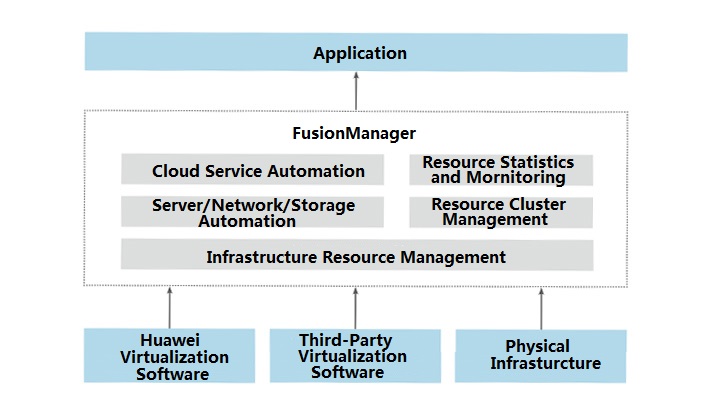FusionManager is a cloud management system that manages Huawei hypervisors. It provides functions such as adding physical devices and VMs, automatically deploying services, and managing and monitoring resources. FusionManager can interconnect to customers' management systems’ using northbound application programming interfaces (APIs) and is compatible with third-party hardware and hypervisors.
Centralized Physical and Virtual Resource Management: Improves Management Efficiency
FusionManager can manage both physical resources (such as subracks, servers, switches, and storage devices) and virtual resources (such as VM resources, virtual network and storage resources) from different systems. The FusionManager software can be installed on either a physical server or a VM.
Automatic O&M: Facilitates Service Deployment
FusionManager provides a tool that allows users to drag and drop icons to design application deployment templates. Administrators can quickly deploy applications by creating templates. In addition, they can configure different scaling policies for different applications. The system then schedules resources based on service loads, application priorities, and configured time-based scheduling policies.
Service Catalogs: Supports Rapid Service Provisioning
FusionManager provides tools for template management and automated template design to facilitate application creation. Administrators can use service catalogs to manage VM templates, software packages, and service templates, and can quickly publish applications using service templates.
High Compatibility: Supports Management of Various Hypervisors
FusionManager provides open APIs for the network management system to obtain information to facilitate management and maintenance of the FusionManager system. FusionManager can manage Huawei virtualization system FusionCompute as well as third-party virtualization systems from different regions in a centralized manner.
| Parameter
|
Value
|
| Supported physical servers
|
4096
|
| Supported VMs
|
80000
|
| Supported logical clusters
|
256
|
| Supported subnets in a zone
|
4096
|
| Supported service VLAN pools in a zone
|
3999
|
| Supported storage pools
|
2000
|
| Supported data centers
|
10
|
| Supported zones
|
512
|
| Supported VDCs*
|
1024
|
* A virtual data center (VDC) is a collection of virtual resources.

